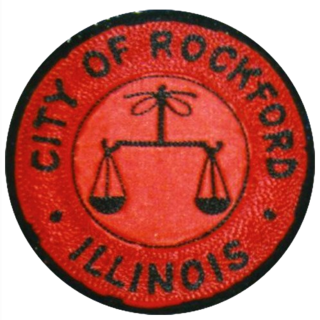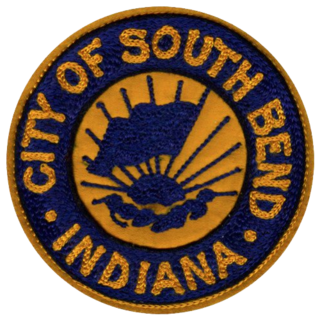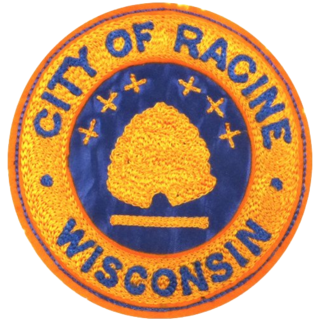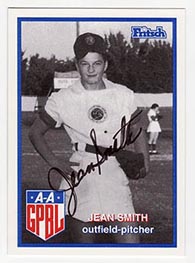
The Rockford Peaches were a women's professional baseball team who played from 1943 through 1954 in the All-American Girls Professional Baseball League. A founding member, the team represented Rockford, Illinois.

The South Bend Blue Sox was a women's professional baseball team who played from 1943 through 1954 in the All-American Girls Professional Baseball League. A founding member, the team represented South Bend, Indiana, and played their home games at Bendix Field (1943–1945) and Playland Park (1946–1954).

The Racine Belles were one of the original teams of the All-American Girls Professional Baseball League playing from 1943 through 1950 out of Racine, Wisconsin. The Belles won the league's first championship. The team played its home games at Horlick Field.

The Fort Wayne Daisies were a women's professional baseball team based in Fort Wayne, Indiana that played from 1945 through 1954 as members of the All-American Girls Professional Baseball League.

The Kalamazoo Lassies were a team who played from 1950 through 1954 in the All-American Girls Professional Baseball League. The team represented Kalamazoo, Michigan. Home games were initially played at Lindstrom Field, but later games were played at the Catholic Athletic Association Field, now the Soisson-Rapacz field. Kalamazoo uniforms were white (home) and gold (away) with dark green numbers, belt, socks, and cap.
Helen Nicol was a Canadian-American baseball pitcher who played from 1943 through 1952 in the All-American Girls Professional Baseball League (AAGPBL). Listed at 5 feet 3 inches (1.60 m), 120 pounds (54 kg), Nicol batted and threw right-handed. She was sometimes credited as Helen Fox or Nickie Fox.
Catherine Horstman [″Horsey″] is a former female utility player who played from 1951 through 1954 in the All-American Girls Professional Baseball League. Listed at 5 ft 7 in (1.70 m), 150 lb., she batted and threw right-handed.
Pauline Pirok [pier-ock] was an infielder who played from 1943 through 1948 in the All-American Girls Professional Baseball League. Listed at 5' 2", 132 lb., Pirok batted and threw right-handed. She earned the nickname Pinky Pirok.

Phyllis C. Koehn [″Sugar″] was an American pitcher and utility who played from 1943 through 1950 for six different teams of the All-American Girls Professional Baseball League. Listed at 5' 5", 120 lb., Koehn batted and threw right-handed. She was born in Madison, Wisconsin.

Kathleen Lois "Flash" Florreich was a pitcher and utility who played from 1943 through 1950 for three different teams of the All-American Girls Professional Baseball League. Listed at 5 ft 5 in (1.65 m), 140 lb., Florreich batted and threw right-handed. She was born in Webster Groves, Missouri.

Constance Wisniewski (Wiśniewski) was a starting pitcher and outfielder who played from 1944 through 1952 in the All-American Girls Professional Baseball League. Listed at 5' 8", 147 lb., she batted left-handed and threw right-handed.
Jean Anna Faut [Winsch/Eastman] was an American starting pitcher who played from 1946 through 1953 in the All-American Girls Professional Baseball League. Listed at 5 ft 4 in (1.63 m), 137 lb., she batted and threw right-handed.

Jean S. Cione [″Cy″] was a pitcher who played from 1945 through 1954 in the All-American Girls Professional Baseball League. Listed at 5' 8", 143 lb., She batted and threw left-handed.

Jean Marie Smith was an outfielder and relief pitcher who played from 1948 through 1954 in the All-American Girls Professional Baseball League. Listed at 5 ft 6 in (1.68 m), 128. lb, she batted and threw right-handed.

The 1943 All-American Girls Professional Baseball League season marked the inaugural season of the circuit. Since the only organized ball for women in the country was softball, the league created a hybrid game that included both softball and baseball.
The 1944 All-American Girls Professional Baseball League season marked the second season of the circuit. The AAGPBL expanded in its second year of existence by adding two franchises to the original four-team format. At this point, the Milwaukee Chicks and the Minneapolis Millerettes joined the Kenosha Comets, Racine Belles, Rockford Peaches and South Bend Blue Sox. The number of games in the schedule also increased to 118, while the final Scholarship Series faced first-half winner Kenosha against Milwaukee, second-half champ, in a Best of Seven Series.
The 1948 All-American Girls Professional Baseball League season marked the sixth season of the circuit. The AAGPBL grew to an all-time peak of ten teams in that season, representing Eastern and Western zones, just in the first year the circuit shifted to strictly overhand pitching. Other modifications occurred during 1948. The ball was decreased in size from 11½ inches to 10⅜ inches, while the base paths were lengthened to 72 feet and the pitching distance increased to 50 feet.
The 1949 All-American Girls Professional Baseball League season marked the seventh season of the circuit. With the Chicago Colleens and Springfield Sallies turning into rookie development teams after the 1948 season, the AAGPBL was left with eight squads: the Kenosha Comets, Fort Wayne Daisies, Grand Rapids Chicks, Muskegon Lassies, Peoria Redwings, Racine Belles, Rockford Peaches and South Bend Blue Sox. The teams competed through a 112-game schedule.
The 1950 All-American Girls Professional Baseball League season marked the eight season of the circuit. The teams Fort Wayne Daisies, Grand Rapids Chicks, Kenosha Comets, Muskegon Lassies, Peoria Redwings, Racine Belles, Rockford Peaches and South Bend Blue Sox competed through a 112-game schedule.













